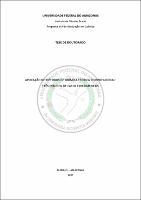| ???jsp.display-item.social.title??? |


|
Please use this identifier to cite or link to this item:
https://tede.ufam.edu.br/handle/tede/8740| ???metadata.dc.type???: | Tese |
| Title: | Aplicação de métodos de química teórica computacional: três estudos de casos experimentais |
| ???metadata.dc.creator???: | Silva, Noam Gadelha da  |
| ???metadata.dc.contributor.advisor1???: | Oliveira, Kelson Mota Teixeira de |
| ???metadata.dc.contributor.referee1???: | Nascimento Junior, Agrinaldo Jacinto do |
| ???metadata.dc.contributor.referee2???: | Pinheiro, Maria Lúcia Belém |
| ???metadata.dc.contributor.referee3???: | Silva, Jefferson Rocha de Andrade |
| ???metadata.dc.contributor.referee4???: | Marques, Alberto dos Santos |
| ???metadata.dc.description.resumo???: | Atualmente, muitos estudos exemplificam as vantagens do uso de métodos teóricos e experimentais combinados. No entanto, muitos pesquisadores assumem a ideia de que as simulações são muito superficiais, distantes da realidade experimental, e isso gera resistência no uso dessas ferramentas teóricas. A presente tese exemplifica como a Química Teórica Computacional contribui para o entendimento de observações experimentais, aproximando o pesquisador do nível atômico e molecular, o que pode ser associado à termodinâmica estatística (ramo da ciência que explora as relações entre as propriedades nos dois níveis). Para o desenvolvimento dessa tese, realizou-se três estudos de caso separados e independentes. Utilizou-se métodos baseados na mecânica quântica (AM1, PM3, PM6 e DFT/B3LYP) e na mecânica molecular (acoplamento molecular e dinâmica molecular). O primeiro estudo de caso comparou quatro compostos similares e derivados, e os resultados, alguns já publicados, confirmam a proximidade da maioria das propriedades. Com estudos de dinâmica molecular, a possibilidade de formação de aglomerados moleculares se mostrou uma interessante abordagem para investigação de atividades biomoleculares. O segundo estudo de caso reproduziu os efeitos interativos de nano-compósito Polianilina/Sílica, explicando como as vibrações moleculares se combinam e se intensificam de forma a sobrepor e “esconder” sinais da sílica. Além disso, aspectos moleculares da polianilina e das interações com a sílica permitiram um melhor entendimento da formação do nano-compósito. O terceiro estudo de caso valida a possibilidade da existência de duas conformações para esqueleto de alcaloide, além de predizer as tendências energéticas de formação de derivados e sugerir uma maneira de “acompanhar” as reações em perspectiva energética e geométrica. Otimizações adaptadas convergem reagentes para produtos, validando a descrição de interações entre nucleófilos e eletrófilos em fase gasosa. |
| Abstract: | Currently, many studies exemplify the advantages of using combined theoretical and experimental methods. However, many researchers assume that the simulations are very superficial, far from the experimental reality, and this generates resistance in the use of these theoretical tools. This thesis exemplifies how Computational Theoretical Chemistry contributes to the understanding of experimental observations, bringing the researcher closer to the atomic and molecular level, which can be associated with statistical thermodynamics (a branch of science that explores the relationships between properties at both levels). For the development of this thesis, three separate and independent case studies were carried out. Methods based on quantum mechanics (AM1, PM3, PM6 and DFT / B3LYP) and molecular mechanics (molecular docking and molecular dynamics) were used. The first case study compared four similar compounds and derivatives, and the results, some already published, confirm the proximity of most properties. With molecular dynamics studies, the possibility of formation of molecular clusters proved to be an interesting approach for investigating biomolecular activities. The second case study reproduced the interactive effects of the polyaniline/silica nano-composite, explaining how the molecular vibrations combine and intensify in order to superimpose and “hide” silica signals. In addition, molecular aspects of polyaniline and interactions with silica allowed a better understanding of the formation of the nano-composite. The third case study validates the possibility of the existence of two conformations for an alkaloid skeleton, in addition to predicting the energy trends in the formation of derivatives and suggesting a way to "follow" the reactions in an energetic and geometric perspective. Adapted optimizations converge reagents for products, validating the description of interactions between nucleophiles and electrophiles in the gas phase. |
| Keywords: | Química quântica Dinâmica molecular |
| ???metadata.dc.subject.cnpq???: | CIENCIAS EXATAS E DA TERRA: QUIMICA |
| ???metadata.dc.subject.user???: | Química teórica Métodos semiempíricos DFT/B3LYP Mecânica molecular Compostos orgânicos |
| Language: | por |
| ???metadata.dc.publisher.country???: | Brasil |
| Publisher: | Universidade Federal do Amazonas |
| ???metadata.dc.publisher.initials???: | UFAM |
| ???metadata.dc.publisher.department???: | Instituto de Ciências Exatas |
| ???metadata.dc.publisher.program???: | Programa de Pós-graduação em Química |
| Citation: | SILVA, Noam Gadelha da. Aplicação de métodos de química teórica computacional: três estudos de casos experimentais. 2022. 252 f. Tese (Doutorado em Química) - Universidade Federal do Amazonas, Manaus (AM), 2021. |
| ???metadata.dc.rights???: | Acesso Aberto |
| ???metadata.dc.rights.uri???: | http://creativecommons.org/licenses/by/4.0/ |
| URI: | https://tede.ufam.edu.br/handle/tede/8740 |
| Issue Date: | 23-Feb-2021 |
| Appears in Collections: | Doutorado em Química |
Files in This Item:
| File | Description | Size | Format | |
|---|---|---|---|---|
| Tese_NoamSilva_PPGQ.pdf | 20.3 MB | Adobe PDF |  Download/Open Preview |
This item is licensed under a Creative Commons License





